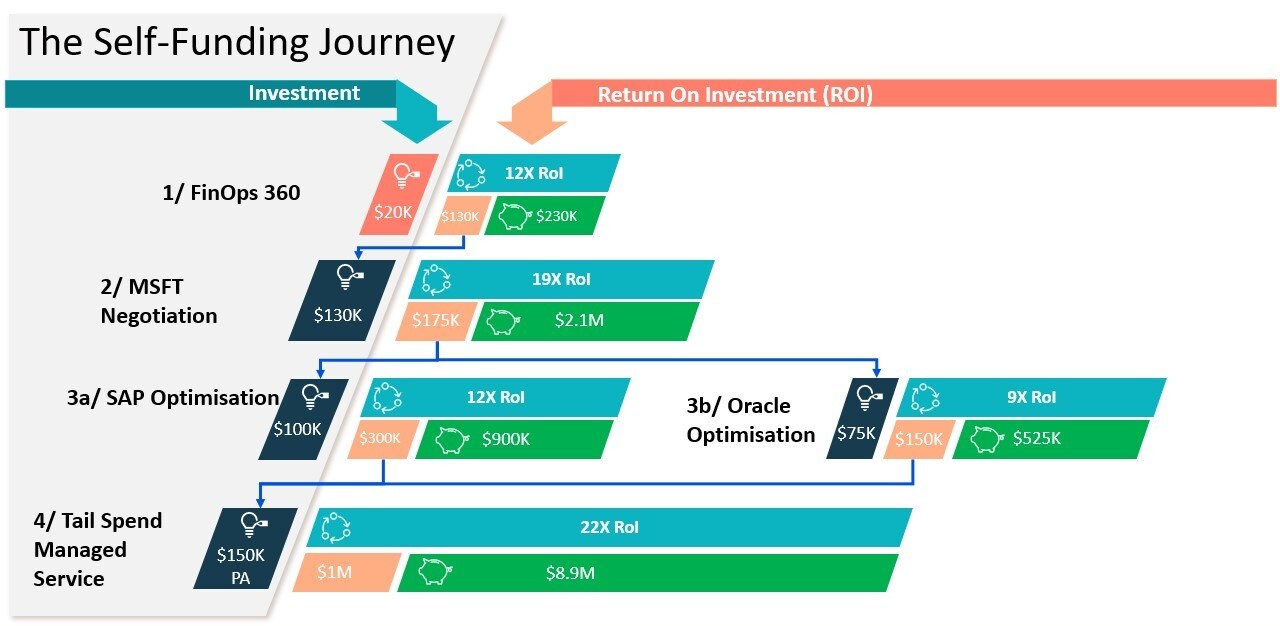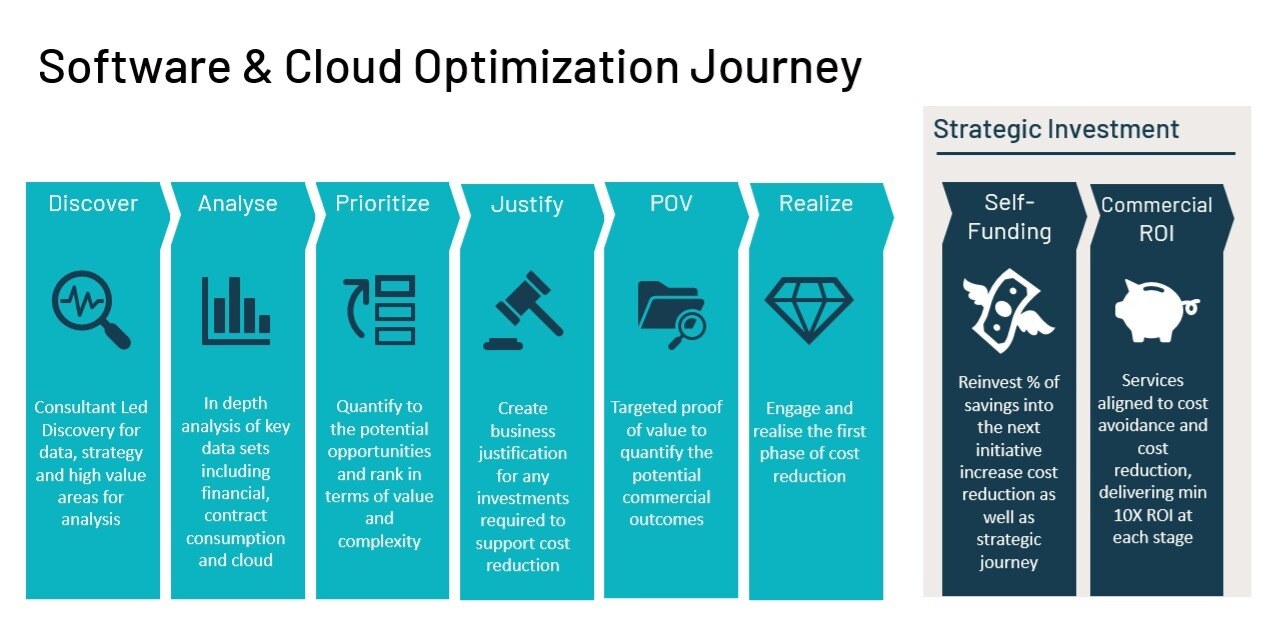How to create a self-funding ITAM practice

If you are responsible for the funding of ITAM or SAM in your organization, this guide explains how to find the funds to evolve your ITAM practice.
Contents
1. Introduction
3. How to create self-funding ITAM
4. Make your ITAM evolution a reality
5. Conclusion
Read on.
Introduction
IT Asset Management (ITAM) isn’t one of those careers that your mother will easily understand. ‘They work in computers’ is probably the phrase typically used to describe what you do. But it’s not just your mother who may fail to understand the value of what ITAM brings.
ITAM has an image problem, stemming from the legacy Software Asset Management (SAM) days when the primary focus was on license compliance.
The industry has evolved massively over time from a compliance-driven practice to a strategic discipline focused on cost optimization, risk management, and operational efficiency. But it still struggles to secure funding for new projects because others fail to understand the value of what ITAM brings.
This guide aims to fix that.
Download a shareable pdf version of this guide
Part 1
Why ITAM needs to change
Before we dive into how to create a self-funding model to pay for ITAM’s evolution, let’s look at why ITAM is under pressure to change.
Over the last decade, the rise of cloud computing, software-as-a-service (SaaS), and virtualization dramatically changed how organizations approached software. The traditional model of on-premises software management evolved into tracking a mix of on-premise, cloud, and hybrid solutions.
As software licensing became more complex (with subscription-based models, pay-per-use, and dynamic pricing), ITAM has shifted to both track usage, and analyze and forecast needs, providing a strategic advantage in vendor negotiations and IT budgeting.
Looking ahead, ITAM is expected to continue evolving, most notably in:
Cloud and SaaS Management
As businesses adopt more cloud-based services, ITAM will focus increasingly on managing cloud resources, optimizing usage, and ensuring proper licenses for cloud environments. Organizations must turn to FinOps practices and hybrid cloud cost optimization strategies to manage the complexity cost-efficiently.
AI and Automation
ITAM tools are integrating more AI and machine learning capabilities to streamline processes like license optimization, contract intelligence, usage monitoring, and predictive analytics. These AI tools will take on the burden of data ingestion and integration, but human insights will make sense of data outputs. This requires skilled employees.
For example, a Cloud Investment Manager (CIM) using an AI tool for cloud or green optimization could get system-generated savings, which don't work in the real world due to intricate variances like disk speeds, geographic issues with data, or carbon intensity. A CIM will work with the AI-generated data to navigate through these quirks to maximise impact.
Vendor Management and Contract Negotiation
As licensing models become more intricate, ITAM will play a crucial role in helping organizations manage vendor relationships, optimize spending, and negotiate favourable terms. This is where some of the biggest cost-savings will be achieved, both around mega-vendor and tail-spend management, the latter often ignored due to other priorities.
Compliance and Sustainability
As regulations around data privacy and software licensing evolve, ITAM will increasingly align with corporate governance and sustainability goals, ensuring companies not only stay compliant but also reduce wasteful spending through the use of GreenOps. ESG reporting is becoming a top priority for organizations, and while reliable GreenOps data is still somewhat challenging, it will rapidly come under the spotlight.
All these shifts are set against macro-economic and geopolitical changes that have a notable impact on organizations, putting them under far greater commercial pressure. This means ITAM needs a commercial lens to make it relevant. In short, ITAM teams must provide evidence that they are saving money.
So how do you do that?

Part 2
How to create self-funding ITAM
Many organizations would love to evolve their ITAM practice or invest more in ITAM but are struggling to land on the commercial outcomes they need to justify those investments. That’s often because they have bloated and inefficient investments in other areas. They may have bought tooling but can’t demonstrate the value of their existing investments and this is blocking them from pursuing a more strategic and evolved approach.
ITAM and digital optimization are incredibly complex areas. They do require investment, but until you can realize savings, it’s impossible to get the funding required. It’s a catch-22.
But there is a way to create a self-funding program of commercial ROI, which can happen at any maturity stage, regardless of whether you have a 10-year-old mature ITAM practice or are right at the start of the process.

The self-funding cycle explained using a Livingstone customer example
If a client wants to do a particular piece of work but they don’t have any budget, we go find the budget.
In the example shown above, the client wanted support to negotiate a Microsoft Enterprise Agreement, but it didn’t have available budget to do it and weren’t comfortable with a gainshare model.
- Livingstone started small and went looking for budget in the client's cloud. We conducted a service called FinOps 360 for ~$20k, which simultaneously provides a FinOps maturity assessment and looks for cloud cost savings.
- Unlike contract renewals, cloud optimization can provide immediate savings. If you switch a workload off in the cloud, you stop paying for it tomorrow. If you pay for a reservation, if you right size, if you do savings plans, all those changes manifest immediately in a dynamic billing mechanism. Within a matter of weeks, we identified and freed up ~$230k – a 12X return on their small initial investment.
- The company reinvested ~$130k of those savings to pay for their Microsoft EA negotiation, budget they would not have had approved initially. This piece of work resulted in $2.1M in savings (a 19X return), which the company could put towards its bottom line or reinvest in new technology.
- In this case, it reinvested some of those savings into SAP and Oracle optimization services, which resulted in a 12X and 9X ROI respectively.
- Finally, the company used some of the savings to address an often-neglected part of IT spend due to the complexity and time-consuming nature of it: tail spend management. Livingstone provided an ongoing managed service to reduce spend on the many smaller software vendors that had been largely ignored in the past. While each vendor’s bill might be small, collectively they added up to millions. This drove an additional £8.9M in savings.
As this example shows, an initial investment of $20k resulted in savings of over $12.5M and evolved the organization’s ITAM practice to be a revenue generator, rather than a cost centre. All these services are designed to pay back within at least the first 12-month period, which you can bank or reinvest into areas that will transform the business.

Want our help?
An ITAM team can follow this same model themselves if they have the resources to do so.
If you need support, Livingstone knows the areas that will help save money. We shine a light on the inefficient investments. We know the areas that are more risk-centric, and we know where to get the maximum benefit from those investments.
This approach unblocks the innovation pipeline so that organizations can start to invest in new tooling, more people, more initiatives, and third parties, all of which cause an evolutionary shift in solving some of the strategic problems faced in their organization.
Part 3
Make your ITAM evolution a reality
If you are a ITAM leader and know you need to evolve your practices, but don’t have the budget or don’t know where to find the savings to fund projects, Livingstone has created a no risk, step-by-step approach that delivers a minimum 10X ROI on any investment.
We work with you to create the business case needed to make your ITAM evolution a reality.

-
Step 1: Discovery
Livingstone will work with you to identify what data you have, what your IT landscape looks like, who is involved, and what the company ambitions are.
We also need to capture data. At this stage it will be limited to commercial information about how much you are currently spending on software and cloud, how that has changed over the last five years, how many suppliers you use, and how many transactions the organization typically makes.
-
Step 2: Analyze
We analyze those numbers, which starts to identify trends like having multiple different transactions with the same providers. This tactic is often used by publishers to divide and conquer within a business and is particularly true if you work for a large complex corporate organization, or a very acquisitive business. The complexity inherent in these kinds of organization can make it harder to get an accurate big picture view of what you are spending, which in turn impacts your buying power to get the best possible deals.
This analysis phase finds out where the money is being spent, what is changing dynamically and how those transactions have happened. While we focus on cloud and software, we also need to understand the maturity of the business because there is little point making a recommendation if the company cannot adopt it.
-
Step 3: Prioritize
Once we have done analysis on the data, we can start to prioritize where those opportunities exist. We rank them by value or complexity. There might be a significantly high value opportunity, but if it takes three years to manifest, it won’t be the right place for us to start. A better jumping off point might be to find a major transaction in the next 12 months, which could drive substantial ROI to fund other initiatives.
Prioritization is based on value and complexity as well as capability to deliver on those recommendations.
-
Step 4: Justify
Even if your plan will save the company millions, you still need to create a business case to justify the initial investment.
You will need to outline why this is needed, when it should start, what investment internally and externally will be needed, and whether you have the right technology in place to drive it forward.
This justification exercise is your business case to land the first opportunity to transform your ITAM practice. We guide you through this to increase your chances of securing funding.
-
Step 5: Proof of Value
Before anybody has parted with money, we do a proof of value (POV). That POV takes all the findings from the previous stages and prove out the investment on one or many of those opportunities.
This will land on an accurate and confident number that your organization can realize based on a particular initiative, whether that’s in your Cloud, on Microsoft, on your tail-spend, or on any one of your publishers.
-
Step 6: Realize
Once we are confident that we're going to generate a significant return on investment, we can obtain the investment and realize those opportunities, implementing the project.
This is your self-funded journey and the evolution of your ITAM practice kicking off.

Conclusion
As a ITAM leader, you are responsible for evolving the practice into something that is future fit. But the days of simply asking for investment without justification are long gone. You need to recognize your organization’s level of maturity, know what data you have, and the opportunities you believe can truly drive ROI. Only then will you gain the confidence and comfort from the organization to invest in the ITAM practice.
That means getting your disparate data sources into one place, using AI to ingest and interpret the data at scale to cope with the burgeoning data volumes, and getting experts in to provide the human intelligence needed to make smart decisions.
It means looking at a self-funding model to drive commercial ROI. Start small and reinvest the savings into bigger projects rather than going with a big bang approach that is likely to fail to secure the required investment.
And it means proving the ROI before you’ve spent any money by following the steps outlined above. Demonstrate to your leadership team how ITAM cuts waste, optimizes spend, finds savings and ultimately becomes a revenue generator.
You quite possibly can’t to do this alone.
Livingstone’s job is to help you find the savings so that you can evolve and mature your ITAM practice, ready to embrace whatever new technology comes next.
Need our help
Contact us for a no obligation chat and let's kickstart your ITAM evolution.
Know someone who would benefit from this guide?
Share it on social.